 |
 |
| Home | Welcome | What's New | Site Map | Glossary | Weather Doctor Amazon Store | Book Store | Accolades | Email Us |
 | |||||||||||||||||||||
The Superior Mirage:
|
|||||||||||||||||||||
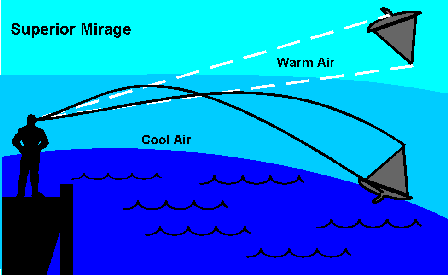 |
This is illustrated in the above diagram. Because of this bending, we see the object floating in the sky, above or even attached to the original object. In cases of strong looming, the image may appear very high in the sky. Looming of a distant ship may be the source of the many legends of flying ghost ships seen by mariners over the centuries. And since the actual ship may be below the geometric horizon, sailors or shoreline viewers might never see it except as a mirage image.
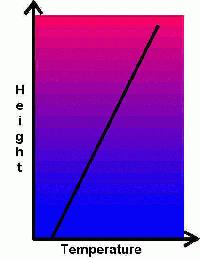 |
Temperature increases with height. |
If the temperature gradient of the layer through which the light travels is constant with height -- that is, the temperature increases at a uniform rate -- no magnification or distortion of the object occurs. However, when the gradient is not uniform, and the temperature increases more rapidly with height as we move away from the surface, then magnification of the object will occur. In many circumstances, we see only a raising of the top of an object to just above its actual position. In such cases, the image appears to be stretched or taller than expected. This situation is called towering.
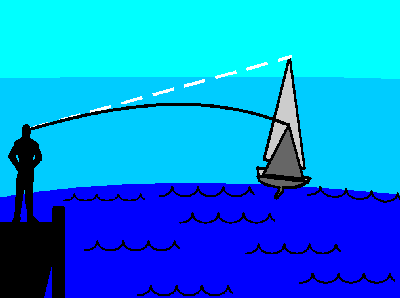 |
Superior Mirage Conditions |
Towering is quite common in polar regions and during the summer near large bodies of relatively cold water when compared to the overlying air temperatures. Such situations are common along North America's Pacific Northwest coastline during the summer. Towering can make coastal mountains appear to rise and fall in height throughout the course of the day when seen from across cold ocean waters. The illusion formed is of the peaks looming higher, and thus the mountains appear closer than they actually are. This illusion can be quite hazardous to sailors navigating by sight alone by causing them to believe they are closer to shore than they actually are.
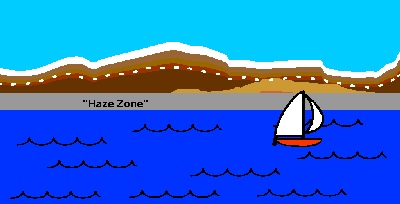 |
The opposite of towering is stooping, a condition where the image appears shorter or further away than it actually is. Stooping occurs when the light from the bottom of the object bends more than the light from the top of the object on its way to the eye. By thus "raising" the lower part of the image more than the upper, the object appears compressed.
We tend to observe mirages most often during the daylight, but superior mirage conditions commonly occur during the night. Indeed, inversion formation is much more frequent during the night hours, at times occurring nightly for long stretches. The advent and spread of artificial light sources during the twentieth century, particularly moving light sources such as the headlights of cars and trucks, can produce some interesting visions.
For example, the superior mirage could be the source for many nighttime UFO sightings. Here's why. The light from headlights on automobiles moving along the highway can be refracted under inversion conditions so that they appear to come from the heavens rather than from the surface where they originated. These images can appear to move quickly across the sky, or they can disappear suddenly as the angle or position of the light beam from the moving vehicle changes.
Since superior mirages are caused by cold air lying beneath relatively warmer air, they are most common and strongest in the Earth's polar regions where the surface is covered by ice or snow or cold seas for most of the year. The arctic mirage is a term that has been applied to superior mirages in northern polar latitudes, particularly when the conditions alter the appearance of the earth's horizon to allow us to see objects that actually are located well beyond or below the geometric horizon.
Also know as the hillingar in Icelandic, the arctic mirage generally forms under conditions of a uniform and widespread temperature inversion. When the temperature rises at a rate of 11 Celsius degrees per 100 metres (6 Fahrenheit degrees per 100 feet), the Earth's horizon will appear flat. If the inversion becomes stronger, the horizon will then appear to rise vertically from the flat position. Thus, when the inversion gradient reaches 18 C deg/100 m (10 F deg/100 ft), the observer will have the illusion of being in a saucer -- that is, the horizon appears as turned upward.
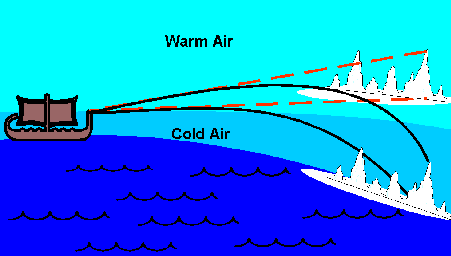 |
Many beliefs and legends of northern inhabitants and European explorers can be attributed to the arctic mirage, and the exploration of polar regions has been both enhanced and hindered by the condition. Many early explorers reported landscape features in polar regions that never really existed but were mere illusions. [For more on the arctic mirage see: The Arctic Mirage: An Aid to Discovery.]
Arctic-type mirages are not confined only to regions north of 60 degrees latitude, however. Robert Greenler in his book Rainbows, Haloes and Glories reported on one interesting situation of superior mirage viewing on the night of 26 April 1977. When the residents of Grand Haven, Michigan looked westward that night across the relatively cold waters of Lake Michigan, they distinctly saw city lights and a flashing red beacon. But the nearest urban area westward from them was Milwaukee, Wisconsin, 120 km (75 miles) away, well below the geometric horizon and thus normally not visible. Their sightings were later confirmed to have been Milwaukee when a Grand Haven resident timed the blink rate of the flashing red light and linked it to the Milwaukee Harbor entrance beacon. (US Weather Service records also confirm that strong inversion conditions were indeed present that night.) The unseeable had indeed briefly become visible.
When the temperature inversion is not as uniform as that found under arctic mirage conditions, a mirage known as the Fata Morgana or halgerndingar (in Icelandic) may appear. In a Fata Morgana mirage, distant objects and features at the horizon appear as spikes, turrets or towers, objects with great vertical exaggeration rising from the surface.
Charles Earle Funk of Funk & Wagnell's Dictionary fame traced the origin of the name Fata Morgana to Italian poets who named what they saw rising up across the Strait of Messina after the fairy castles of Morgana. Literally, Fata Morgana means the Fairy Morgana, a reference to the English legends of King Arthur's enchanted sister Morgana, who dwelled in a crystal castle beneath the sea.
According to meteorologist William J. Humphreys, Morgana is also a Breton word for sea woman which further connects the name with the mirage. He writes of a mirage appearing as crystal palace rising from beneath the waves of the Strait of Messina and
"molding the bluffs and houses of the opposite shore into wondrous castles that, alike, tower into the sky and sink beneath the surface; nor is it strange that this poetic name should become generic, as it has, for all such multiple mirages, whenever they occur." [Physics of the Air, 1920]
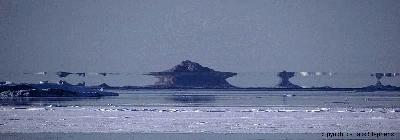 |
©1999, Jack Stephens Images, All Rights Reserved. Used with permission. |
A striking example of the Fata Morgana photographed in Greenland by Jack Stephens is shown here. Like the arctic mirage, the Fata Morgana can give explorers the appearance of large and significant landmarks such as coastal cliffs or mountains. But in fact, they may only be low hills, beaches or sea ice distorted so that they appear as mountain ranges rising ahead.
Alistair Fraser, an expert on atmospheric optics at Pennsylvania State University, attributes the Fata Morgana to a situation where the temperature increases slowly with height from the surface until it reaches a shallow air layer where the increase in temperature becomes quite rapid. This layer is then topped with another layer of slowly increasing temperature. This atmospheric temperature structure will magnify objects whose light rays pass through the middle layer. Minor spatial variations in the inversion pattern can project a complex image pattern toward the observer. Variations in the degree, thickness or location of the layer may even cause relatively smooth surfaces of water or snow to appear as a line of irregular towers and spires.
Under similar conditions to those which form a Fata Morgan mirage, one may see a Fata Bromosa instead, or even in combined with it. The Fata Bromosa or fairy fog is characterized by less distinct elements than with the Fata Morgana. It generally appears as a flat and uniform image, like an overhanging wall, with strong variation in brightness rather than surface detail. The bright and dark patches are caused by a degree of "fuzziness" in the magnified images as the light rays are distributed more strongly in areas above and below the image than one would expect. Because the image is blurred and brighter than expected, it gives the impression of a luminous fog bank hovering just above the sea, snow or ice surface.
In the winter of 1596, a ship under the command of Willem Barents in search for the Northeast Passage to Asia was ice-bound off the north coast of the Russian arctic island of Novaya Zemlya (latitude 76 degrees North). Barents and his officers were astonished one day in early March to see a distorted sun appear for a short time above the horizon. They had not expected to see the breaking of the long arctic night at this latitude for another few weeks. Yet, there it appeared, approximately 5 degrees of arc higher than its actual position.
Because such mirages were rarely seen by Europeans, Barents' reports were not taken seriously by scientists of his time. Indeed, his observations were not confirmed for over three centuries when, in 1915 and half a world away, Sir Ernest Shackleton briefly observed a distorted sun suddenly visible over the horizon seven days after it had set for the Antarctic winter night.
The Novaya Zemlya mirage requires the sun's rays to travel within an inversion layer for hundreds of kilometres. The layer must have just the right temperature gradient so that the light more or less continuously bends with the curvature of the Earth over that long distance -- 400 km (250 miles) for a 5 degree elevation rise according to calculations by W.H. Lehn -- to allow a sighting of the sun's disk.
With many permanent or long-term scientific settlements in polar regions established over the last fifty years, the Novaya Zemlya mirage has been more frequently observed and even photographed.
Mirages open a whole new aspect to sky watching. Perhaps we have been viewing instances of superior mirages for years without even realizing what we were seeing, or not seeing. Because they were unknown to us, they were often also unseen. What interesting stories may have arisen if the flashing harbour light of Milwaukee had been the only light visible that night to the residents of Grand Haven and had perhaps also been distorted by Fata Morgana conditions? What tales of UFOs may emerge when car headlights located below the horizon are seen under looming and magnification conditions of a strong superior mirage? Could those luminous disks darting around the heavens at unusual speed and motion be only the beams from headlights of a Volkswagen Beetle bent through the air?
Now that you know what to look for, take some time to look closely when conditions are right for superior mirage formation, and you may observe some surprising scenes. And perhaps get a feel for the stuff legends are made of.
For details on mirages, their causes and properties, see
The Mirage: A Primer in the Weather Elements and Phenomena Section,
The Inferior Mirage: Not Just For Deserts Anymore in the Weather Elements and Phenomena Section,
The Arctic Mirage: An Aid to Discovery in the Weather People and History Section.
and
Did Those Mountains Grow Overnight? in the Weather Almanac Section.
 |
To Purchase Notecard, |
Now Available! Order Today! | |
 |
 |
NEW! Now Available in the US! |
The BC Weather Book: |


